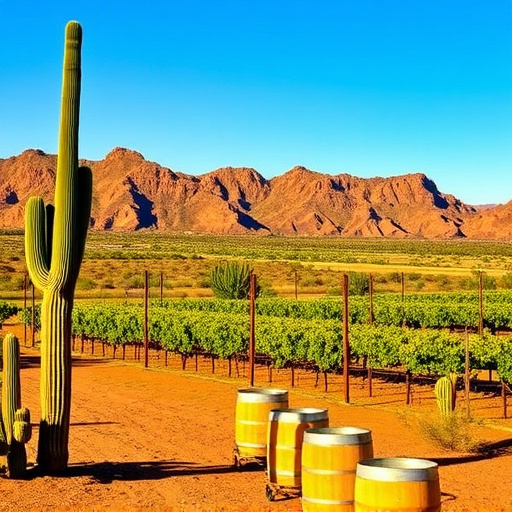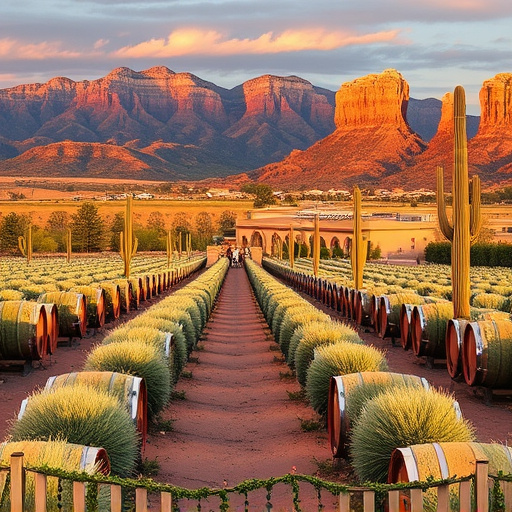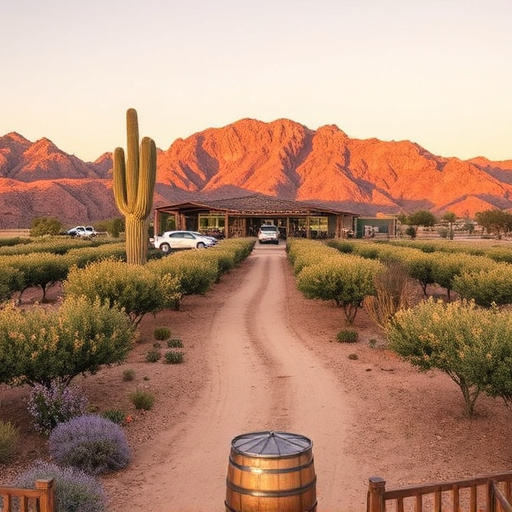Southern Arizona's unique climate and diverse soils make it an ideal location for sustainable viticulture, attracting wine enthusiasts seeking authentic experiences. Winemakers are adopting dry farming techniques, minimizing irrigation and relying on natural rainfall, resulting in high-quality, distinctive wines. These eco-friendly practices, including organic farming methods like cover cropping, position Southern Arizona wineries as leaders in sustainable wine production while addressing water scarcity and environmental impact.
“Uncover the secrets of sustainable viticulture in Southern Arizona’s stunning landscape. This region’s unique ecosystem, characterized by arid climates and nutrient-rich soils, has positioned it as a pioneer in eco-friendly wine production. Delve into the art of dry farming, a traditional technique that minimizes water usage, fostering a healthier environment.
Explore top southern Arizona wineries leading the charge in sustainable practices. From their innovative approaches to their impact on the industry, these vineyards offer an immersive experience for wine enthusiasts seeking a deeper connection with nature. Learn how to tour these sustainable sites and contribute to a greener future while savoring exceptional wines.”
- The Unique Ecosystem of Southern Arizona: Ideal for Sustainable Viticulture
- – Exploring the climate and soil conditions that support eco-friendly wine production.
- Dry Farming Techniques: A Sustainable Approach to Winemaking
- – Detailed explanation of dry farming, its benefits for the environment, and the challenges it presents.
The Unique Ecosystem of Southern Arizona: Ideal for Sustainable Viticulture

Southern Arizona presents a unique and ideal ecosystem for sustainable viticulture, making it a hidden gem among wine enthusiasts seeking authentic experiences. The region’s climate, characterized by hot, dry summers and mild winters, perfectly aligns with the principles of dry farming—a sustainable practice that minimizes irrigation. This arid environment is further enhanced by the state’s high altitude, which contributes to a slower ripening process for grapes, allowing them to develop complex flavors and higher acidity.
The soil types found in many southern Arizona vineyards are another significant advantage. The region boasts diverse soils, including sandy loams and gravelly soils, that promote excellent drainage, preventing waterlogging and root rot—common issues in traditional farming. This natural filtration system ensures healthy grapevines and produces exceptional wines with distinctive character, reflecting the terroir of this remarkable wine-growing region.
– Exploring the climate and soil conditions that support eco-friendly wine production.

In Southern Arizona, wineries are embracing sustainable practices that harmonize with the region’s unique climate and soil. The area’s arid conditions, characterized by warm summers and low rainfall, naturally lend themselves to dry farming techniques—a method that minimizes irrigation and promotes deep root growth in vines. This eco-friendly approach not only conserves water but also results in wines with distinct character and terroir.
Soil composition plays a crucial role as well. The region’s diverse geology offers a variety of soil types, each contributing unique mineral qualities to the grapes. Winemakers carefully manage these soils by implementing organic farming practices, such as cover cropping and composting, to maintain nutrient levels and support the health of the ecosystem. This holistic approach ensures that Southern Arizona wineries produce high-quality, sustainable wines while preserving the delicate balance of their environments.
Dry Farming Techniques: A Sustainable Approach to Winemaking

In the heart of southern Arizona, wineries are leading the charge in sustainable practices, and dry farming is at the forefront of this movement. This ancient technique involves minimal to no irrigation, relying on nature’s rhythm and the soil’s inherent moisture retention capabilities. By forgoing traditional watering methods, vineyards embrace a more eco-friendly approach, reducing water consumption and minimizing their environmental footprint.
Dry farming encourages deeper root systems as grapes struggle for water, resulting in stronger, healthier plants. This method also promotes higher sugar concentrations in the grapes, leading to richer, more intense wines. Southern Arizona’s unique climate, characterized by hot summers and low humidity, lends itself perfectly to dry farming, making it an ideal region for wineries looking to embrace sustainability without compromising quality.
– Detailed explanation of dry farming, its benefits for the environment, and the challenges it presents.

Dry farming, practiced by some forward-thinking wineries in Southern Arizona, is an ancient agricultural method that has gained prominence in recent years as a sustainable approach to viticulture. Unlike traditional irrigation, dry farmers rely solely on rainfall and minimal human intervention to cultivate their grapes. This technique requires significant patience and long-term thinking since the vines must access deep soil moisture during scarce rainfall periods.
The environmental benefits of dry farming are substantial. It significantly reduces water usage, making it an attractive option in arid regions like Southern Arizona where water scarcity is a pressing issue. Moreover, by minimizing chemical fertilizers and pesticides, this method promotes healthier soils and reduces the potential pollution of nearby water sources. However, dry farming presents unique challenges, such as increased vulnerability to extreme weather events and higher initial investment costs for necessary soil amendments and strategic planting techniques.
Southern Arizona’s unique ecosystem offers ideal conditions for sustainable viticulture, with its arid climate and well-draining soils perfectly suited to dry farming techniques. By embracing these eco-friendly practices, local wineries are not only producing high-quality wines but also preserving the region’s natural heritage. Exploring these southern Arizona wineries and their commitment to sustainability is a refreshing journey that showcases the future of wine production—one that balances environmental stewardship with exceptional taste.
